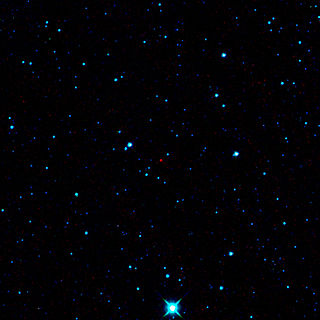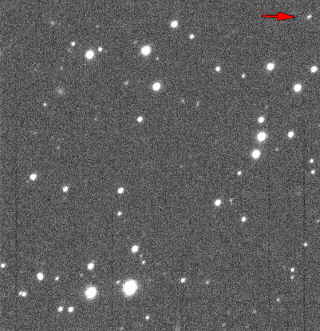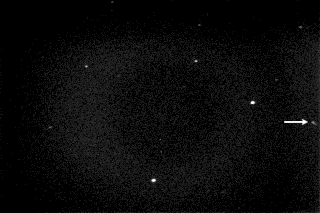Related Research Articles
4401 Aditi is an eccentric, stony asteroid, classified as a near-Earth object and Amor asteroid, approximately 1.8 kilometers in diameter. It was discovered on 14 October 1985 by American astronomer Carolyn Shoemaker at Palomar Observatory in California, and later named after the Hindu goddess Aditi.
2368 Beltrovata, provisional designation 1977 RA, is an eccentric stony asteroid and near-Earth object of the Amor group, approximately 2.7 kilometers in diameter. It was discovered on 4 September 1977, by Swiss astronomer Paul Wild at Zimmerwald Observatory near Bern, Switzerland. The asteroid was named for Betty Tendering, a friend of author Gottfried Keller.

1917 Cuyo is an stony asteroid and near-Earth object of the Amor group, approximately 5.7 kilometers in diameter. It was discovered on 1 January 1968, by astronomer Carlos Cesco and A. G. Samuel at El Leoncito Observatory, Argentina.
3288 Seleucus, provisional designation 1982 DV, is a rare-type stony asteroid, classified as near-Earth object of the Amor group of asteroids, approximately 2.5 kilometers in diameter. It was discovered on 28 February 1982, by German astronomer Hans-Emil Schuster at ESO's La Silla Observatory site in northern Chile. It was named after the Hellenistic general and Seleucid ruler Seleucus I Nicator.

(614599) 2010 AB78 is a dark asteroid on an eccentric orbit, classified as near-Earth object of the Amor group. It was first observed by the Wide-field Infrared Survey Explorer (WISE) on 12 January 2010. The asteroid measures approximately 1.7 kilometers in diameter and has a low albedo of 0.03, which is rather typical for carbonaceous asteroids.
(5646) 1990 TR is a probable rare-type binary asteroid classified as near-Earth object of the Amor group, approximately 2.3 kilometers in diameter. It was discovered on 11 October 1990, by Japanese astronomers Seiji Ueda and Hiroshi Kaneda at Kushiro Observatory near Kushiro, in eastern Hokkaido, Japan.
(6491) 1991 OA is a highly eccentric, stony asteroid, classified as near-Earth object and potentially hazardous asteroid, approximately half a kilometer in diameter. It was discovered on 16 July 1991, by American astronomer Henry E. Holt at the U.S. Palomar Observatory in California.
(7025) 1993 QA is a sub-kilometer asteroid classified as near-Earth object of the Apollo and Amor group, respectively. It was discovered on 16 August 1993, by astronomers of the Spacewatch program at the Kitt Peak National Observatory near Tucson, Arizona, United States. The asteroid measures approximately half a kilometer in diameter and has a short rotation period of 2.5057 hours.
(242450) 2004 QY2 (prov. designation:2004 QY2) is an asteroid on an eccentric orbit, classified as near-Earth object and potentially hazardous asteroid of the Apollo group, approximately 3 kilometers (2 miles) in diameter. It was discovered on 20 August 2004 by the Siding Spring Survey at an apparent magnitude of 16.5 using the 0.5-metre (20 in) Uppsala Southern Schmidt Telescope. It is one of the largest potentially hazardous asteroids known to exist.

(511002) 2013 MZ5, provisional designation 2013 MZ5, is a sub-kilometer asteroid, classified as a near-Earth object of the Amor group, estimated to measure approximately 300 meters (1,000 feet) in diameter. It was discovered on 18 June 2013, by astronomers with the Pan-STARRS survey at Haleakala Observatory on the island of Maui, Hawaii, in the United States. It was the 10,000th near-Earth object ever discovered.

(162058) 1997 AE12 is a stony, sub-kilometer asteroid and likely the slowest rotator known to exist. It is classified as near-Earth object of the Amor group and measures approximately 800 meters in diameter. The asteroid was discovered on 10 January 1997 by the Spacewatch survey at Kitt Peak National Observatory near Tucson, Arizona

(190166) 2005 UP156 is a stony asteroid and binary system, classified as near-Earth object of the Apollo group, approximately 1 kilometer in diameter. It was discovered on 31 October 2005, by astronomers of the Spacewatch survey at the Kitt Peak National Observatory in Arizona, United States. Its minor-planet moon with an orbital period of 40.25 hours was discovered in 2017.
(89830) 2002 CE, is a stony asteroid, classified as near-Earth object and potentially hazardous asteroid of the Amor group, approximately 3.1 kilometers in diameter. It was discovered on 1 February 2002, by astronomers of the LINEAR program at Lincoln Laboratory's Experimental Test Site near Socorro, New Mexico, in the United States. This asteroid is one of the largest potentially hazardous asteroid known to exist.
(90075) 2002 VU94 (provisional designation 2002 VU94) is an asteroid on an eccentric orbit, classified as near-Earth object and potentially hazardous asteroid of the Apollo group, approximately 2.5 kilometers in diameter. It was discovered on 13 November 2002, by astronomers of the Near-Earth Asteroid Tracking program at Palomar Observatory in California, United States. It is one of the largest potentially hazardous asteroids known.
(159857) 2004 LJ1, provisional designation 2004 LJ1, is an asteroid on an eccentric orbit, classified as near-Earth object and potentially hazardous asteroid of the Apollo group, approximately 3 kilometers in diameter. The asteroid was discovered on 10 June 2004, by astronomers of the LINEAR program at Lincoln Laboratory's Experimental Test Site near Socorro, New Mexico, in the United States. It is one of the largest potentially hazardous asteroids known to exist.

(505657) 2014 SR339, provisional designation 2014 SR339, is a dark and elongated asteroid, classified as near-Earth object and potentially hazardous asteroid of the Apollo group, approximately 970 meters (3,200 feet) in diameter. It was discovered on 30 September 2014, by NASA's Wide-field Infrared Survey Explorer telescope (WISE) in Earth's orbit. Closely observed at Goldstone and Arecibo in February 2018, it has a rotation period of 8.7 hours.
(163243) 2002 FB3, provisional designation 2002 FB3, is a stony asteroid on an eccentric orbit, classified as near-Earth object and potentially hazardous asteroid of the Athen group, approximately 1.6 kilometers (1 mile) in diameter. It was discovered on 18 March 2002, by astronomers with the Lincoln Near-Earth Asteroid Research at the Lincoln Laboratory's Experimental Test Site near Socorro, New Mexico, in the United States. The Q-type asteroid has a rotation period of 6.2 hours.
(85182) 1991 AQ is a stony asteroid on a highly eccentric orbit, classified as near-Earth object and potentially hazardous asteroid of the Apollo group, approximately 1.1 kilometers in diameter. It was discovered on 14 January 1991, by American astronomer Eleanor Helin at the Palomar Observatory in California. Based on its brightness variation of 0.69 magnitude, this Q-type asteroid is likely elongated. It belongs to the small group of potentially hazardous asteroids larger than one kilometer.
(154276) 2002 SY50, provisional designation 2002 SY50, is a stony asteroid on a highly eccentric orbit, classified as near-Earth object and potentially hazardous asteroid of the Apollo group, approximately 1.1 kilometers (0.7 miles) in diameter. It was discovered on 30 September 2002, by astronomers with the Lincoln Near-Earth Asteroid Research at the Lincoln Laboratory's Experimental Test Site near Socorro, New Mexico, in the United States. The K-type asteroid has a rotation period of 4.8 hours. It will make a close encounter with Earth on 30 October 2071.
(172034) 2001 WR1, provisional designation: 2001 WR1, is a sub-kilometer near-Earth object of the Amor group, approximately 650 meters (2,100 feet) in diameter. The S-type asteroid has been identified as a potential flyby target of the Hayabusa2 mission. It was discovered on 17 November 2001, by astronomers with the Lincoln Near-Earth Asteroid Research at the Lincoln Laboratory's Experimental Test Site near Socorro, New Mexico, in the United States. The asteroid has a rotation period of 8.0 hours and possibly an elongated shape. It remains unnamed since its numbering in December 2007.
References
- 1 2 3 4 5 6 7 8 "JPL Small-Body Database Browser: 391211 (2006 HZ51)" (2017-11-21 last obs.). Jet Propulsion Laboratory . Retrieved 30 January 2018.
- 1 2 3 4 5 "391211 (2006 HZ51)". Minor Planet Center . Retrieved 30 January 2018.
- 1 2 3 4 Nugent, C. R.; Mainzer, A.; Masiero, J.; Bauer, J.; Cutri, R. M.; Grav, T.; et al. (December 2015). "NEOWISE Reactivation Mission Year One: Preliminary Asteroid Diameters and Albedos". The Astrophysical Journal. 814 (2): 13. arXiv: 1509.02522 . Bibcode:2015ApJ...814..117N. doi:10.1088/0004-637X/814/2/117. S2CID 9341381 . Retrieved 30 January 2018.
- 1 2 3 4 "Big new asteroid has slim chance of hitting Earth". New Scientist. 2 May 2006. Retrieved 30 January 2018.
- ↑ "LCDB Data for (391211)". Asteroid Lightcurve Database (LCDB). Retrieved 30 January 2018.